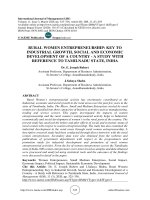Economic growth and economic development 567
Bạn đang xem bản rút gọn của tài liệu. Xem và tải ngay bản đầy đủ của tài liệu tại đây (105.32 KB, 1 trang )
Introduction to Modern Economic Growth
results; the monopolist has lower incentives to undertake innovation than the firm
in a competitive industry, because with its innovation will replace its own already
existing profits. In contrast, a competitive firm was making zero profits, and thus
had no profits to replace.
An immediate and perhaps more useful corollary of this proposition is the following:
Corollary 12.1. An entrant will have stronger incentives to undertake an innovation than an incumbent monopolist.
The potential entrant is making zero profits without the innovation. If it undertakes the innovation it will become the ex post monopolist and make profits equal
ˆ I1 . Both of these are greater than the additional profits that the incumbent
to π I1 or π
would make by innovating, ∆ˆ
π I1 . This is a direct consequence of the replacement
effect; while the incumbent would be replacing its own profit-making technology, the
entrant would be replacing the incumbent. The replacement effect and this corollary
imply that in many models entrants have stronger incentives to invest in R&D than
incumbents.
The observation that entrants will often be the engine of process innovations
takes us to the realm of Schumpeterian models. Joseph Schumpeter characterized
the process of economic growth as one of creative destruction, meaning a process in
which economic progress goes hand-in-hand with the destruction of some existing
productive units. Put differently, innovation is driven by the prospect of monopoly
profits. Because of the replacement effect, it will be entrants, not incumbents, that
undertake greater R&D towards inventing and implementing process innovations.
Consequently, innovations will displace incumbents and destroy their rents. According to Schumpeter, this process of creative destruction is the essence of the capitalist
economic system. We will see, especially in Chapter 14, that the process of creative
destruction can be the essence of economic growth as well.
In addition to providing an interesting description of the process of economic
growth and highlighting the importance of the market structure, the process of creative destruction is important because it also brings political economy interactions
to the fore of the question of economic growth. If economic growth will take place
553









